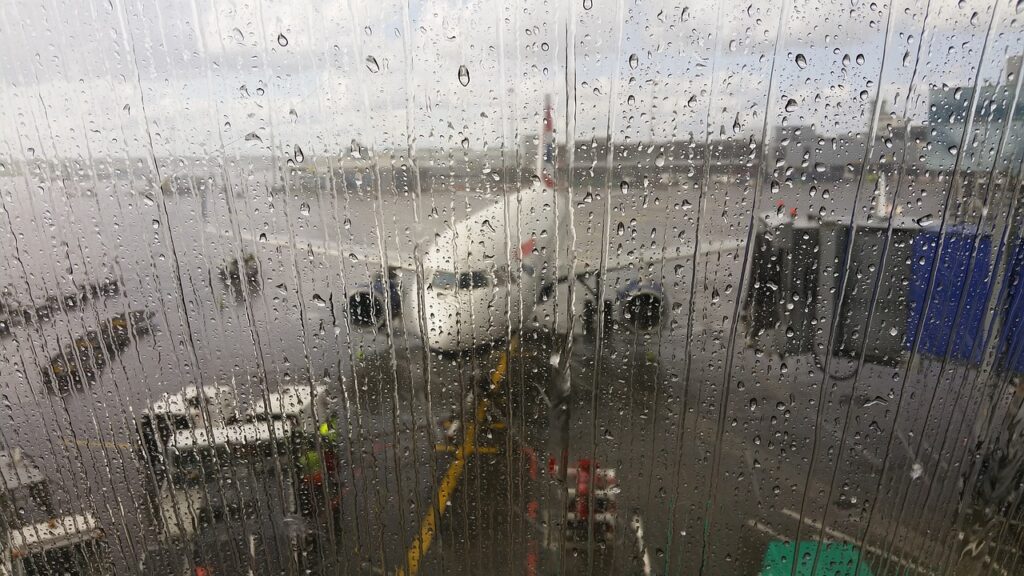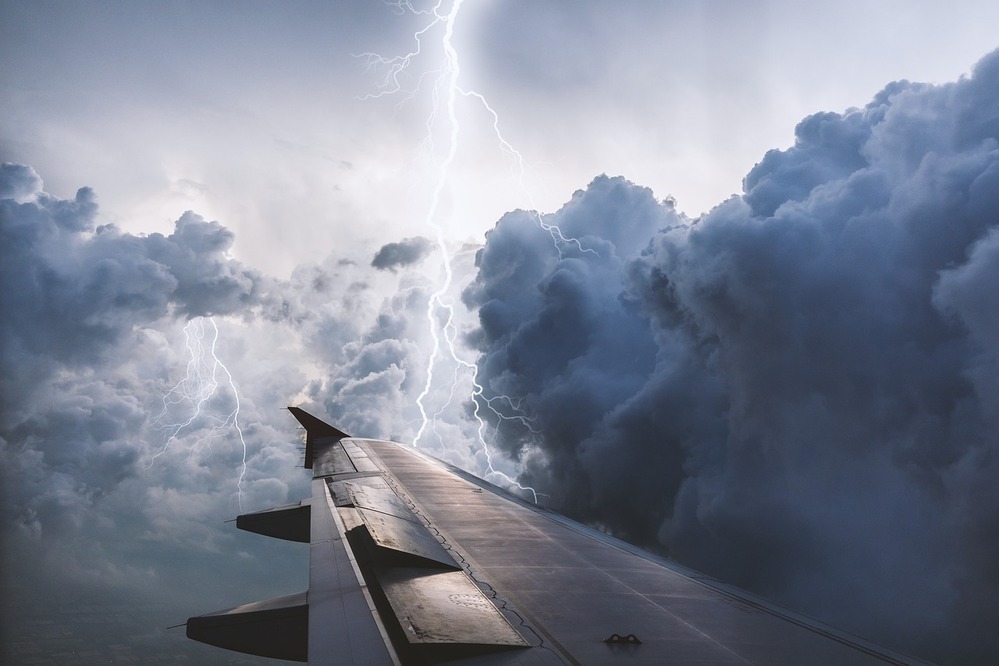Flight delays are a fact of airline travel, and a major factor contributing to them is the weather. Bad weather is to blame for 75.48% of delays in the U.S. airspace system that last longer than 15 minutes, based on 2022 data from the Federal Aviation Administration (FAA). This statistic highlights the far-reaching repercussions that bad weather can have on air travel. Whether heavy rain, snow, or strong winds, knowing just how bad the weather has to be before a flight is delayed is vital information for both airlines and passengers.
This article looks at the different weather factors that lead to delays and what you should know when experiencing weather flight delays.
Weather Factors That Can Cause Flight Delays

It is not unusual to have flight delays due to weather, and this is a normal challenge in the travel delay toolkit. Every specific factor may affect flying conditions, meaning it can actually cause delays or, in more severe cases, cancellations. Such conditions impact visibility, aircraft performance, and runway safety, complicating airlines’ efforts to stick to their schedules.
Below, we examine the specific weather factors that most often cause flights to be delayed because of weather, and the reasons behind their significant impact on air travel.
Flying in Low Clouds
Light clouds can sharply impact visibility and make taking off and landing at low altitudes difficult. Visual references are important to pilots, particularly during these flight phases. If cloud cover is too low, it may not be safe to proceed, and this can lead to delays. Aircraft may have to hold for improved conditions or may need to divert to a nearby alternate airport, adding to further disruptions.
Flying in Fog
Fog can greatly reduce visibility, leading to flight delays as well. It can hide runways, taxiways and other planes from view, making it hard for pilots to fly safely through. Airports might remain suspended until the fog has lifted, especially in cases where Instrument Landing Systems (ILS) are unable to fully counter the decreased visibility. This often leads to delayed departures and arrivals.
Flying in Heavy Rain
Heavy rain presents many challenges for pilots and airport operations, with weather-related flight delays a common occurrence. Rain could affect visibility, which hinders pilots from seeing the runway and other aircraft. And significant rain can result in slippery runway conditions which can even heighten the risk of hydroplaning on takeoff or landing. This may cause delays while pilots and air traffic control await safer conditions, or even force aircraft to divert to other airports with better weather conditions.
Flying in Strong Winds
Wind is another major cause of weather-related flight delays. Strong winds are particularly difficult during takeoff and landing since they shove the plane off course. Gusty winds can also create turbulence, which, while not typically dangerous, can make for a very uncomfortable flight. Airports might ground flights until winds die off to a safe level, especially if their speeds exceed safety protocols. Crosswinds of 30-35 kts (34-40 mph) are generally the threshold for safe landings and take offs for commercial aircraft, but that can vary by type of aircraft. Gusts above this level can cause major schedule meltdowns, particularly in the windy parts of the country.
Flying in Snow or Ice
Flight delays because of weather are most often an issue in the winter when snow and ice are a factor. Snow can build up on runways, making them slippery and unsafe for takeoff and landing. Ice can also accumulate on aircraft surfaces, which can change the aerodynamics and potentially lead to accidents. Before a flight can depart, an ice-removal process is performed, which can lead to major delays. Airports may also need to close runways temporarily to clear snow and ensure safe operations, further contributing to flights delayed due to weather.
Flying in Thunderstorms

Thunderstorms are one of the deadliest weather phenomena impacting air travel. Thunderstorms can generate dangerous turbulence, lightning strikes and high winds, all of which are serious hazards for aircraft. Thunderstorms near an airport can cause the complete shutdown of all flight activity because pilots will not fly through this type of dangerous weather. Additionally, thunderstorms can knock out air traffic control systems, meaning there may be delays even after the storm moves away. Flights are frequently delayed or diverted until normal operations can safely resume for these reasons.
Flying in Sun and Heat
It may sound a little counterintuitive, but extreme sun and heat can actually cause weather-related flight delays. When the airplane is flying and its engines are operating, high ambient temperatures can impact the performance of the airplane, particularly during the takeoff phase. Hot air is less dense than cold air; thus, airplanes need longer runways to lift off. In some instances, particularly at airports located at higher altitudes, flights will either be delayed until temperatures decrease, or aircraft will have to cut weight by capping the number of passengers or cargo. These safety measures can lead to delays and disruptions, especially during heatwaves.
Statistics on Flight Delays due to Weather
To better understand how different weather conditions affect flight schedules, the following table shows the percentage of flights delayed by each factor:
| 🌦️ Weather Condition | Percentage of Delays |
| ⛈️ Thunderstorms | 25% |
| ❄️ Snow or Ice | 20% |
| 🌧️ Heavy Rain | 15% |
| 🌫️ Low Clouds | 12% |
| 💨 Strong Winds | 10% |
| 🌁 Fog | 8% |
| ☀️ Sun and Heat | 5% |
These statistics give us insight into how various weather conditions contribute to overall delays. Thunderstorms and snow or ice are the leading causes, but other factors like heavy rain and high winds also have a significant impact on travel plans.
Do Airlines Compensate for Weather Delays?
Airlines generally are not required to compensate for flight delays caused by weather since these delays are beyond the airlines’ control. Thunderstorms, snowstorms, and similar events qualify as “extraordinary circumstances,” meaning airlines are not legally mandated to provide compensation to travelers. However, some airlines might offer assistance, such as meal vouchers or hotel stays, particularly if the delay is an extended one.
💼 Pro Traveler’s Tip: Download multiple airline apps on your phone before your trip. This way, if your original airline cancels the flight, you can quickly check for alternative routes on competing airlines.
FAQ
Usually, airlines aren’t responsible for compensating travelers for weather delays. Because these delays are attributed to things the airline cannot control, like tornadoes, fog or snow, they fall under the category of “extraordinary circumstances.” As a result, flight delay due to weather compensation is usually not offered. However, some airlines may still provide amenities like meal vouchers or accommodations depending on the length of the delay.
Multiple types of weather can lead to a delayed flight, among them low clouds, fog, heavy rain, strong winds, snow, ice and thunderstorms. Heat can also disrupt flight schedules, especially at high-altitude airports. These conditions can reduce visibility, create unsafe runway conditions, or impact aircraft performance, leading to flight delays because of the weather.
To see if the weather could potentially impact your flight, look up what the forecast is like in both where you are leaving from and headed to. You can also keep an eye on updates from the airline, which will let you know if you see any flight weather delays. Flight status-tracking apps and websites can also help alert you if your flight is likely to be affected by adverse weather.
So, technically, there’s no time frame that says how long a flight can sit on the tarmac with bad weather. Delays vary from minutes to several hours, depending on how quickly conditions improve. At the extremes, flights can be held over night or cancelled. How long a delay lasts can vary greatly depending on how severe and/or persistent the weather conditions are, along with how quickly the airlines and airport can safely get back into business.
